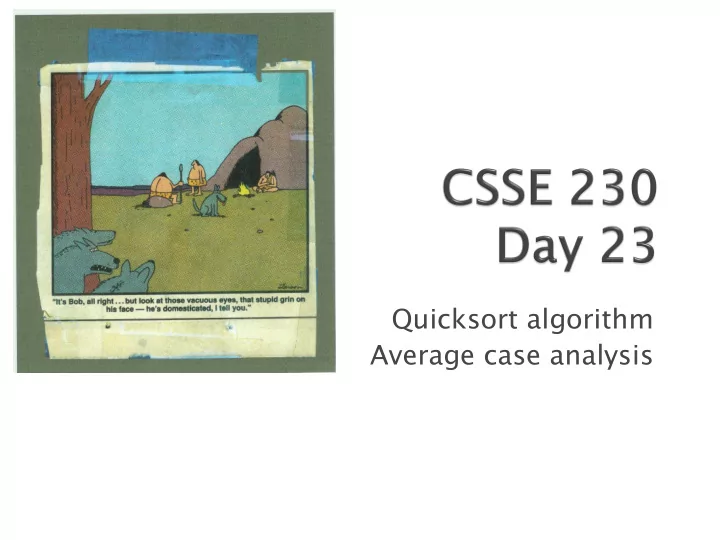

Quicksort algorithm Average case analysis
http://www.xkcd.com/1185/ Stacksort connects to StackOverflow, searches for “sort a list”, and downloads and runs code snippets until the list is sorted.
Q1-3 Q1 For any recurrence relation of the form: with The solution is: Notes: Replace O with θ 1. Add quiz 3c: T(N) = 27T(N/3) + θ (N 2 ) 2. Theorem 7.5 in Weiss
http://maven.smith.edu/~thiebaut/java/sort/ demo.html http://www.cs.ubc.ca/~harrison/Java/sorting -demo.html www.sorting-algorithms.com
Invented by C.A.R. “Tony” Hoare in 1961* Very widely used Somewhat complex, but fairly easy to understand ◦ Like in basketball, it’s all about planting a good pivot. *See Tony’s own story about how it happened, at http://research.microsoft.com /en-us/people/thoare/. Image from http://www.ultimate-youth-basketball-guide.com/pivot-foot.html.
Q4
Q5 Q5 // Assume min and max indices are low and high pivot = a[low] i = low+1, j = high while (true) { while (a[i] < pivot) i++ while (a[j] > pivot) j-- if (i >= j) break swap(a, i, j) } swap(a, low, j) // moves the pivot to the // correct place return j
Q6-7 Q6 Running time for pa parti rtitio ion of of N N el elem ements is Θ (N) Quicksort Running time: ◦ call partition. Get two subarrays of sizes N L and N R (what is the relationship between N L , N R , and N?) ◦ Then Quicksort the smaller parts ◦ T(N) = N + T(N L ) + T(N R ) Quicksort Best case: write and solve the recurrence Quicksort Worst case: write and solve the recurrence average: a little bit trickier ◦ We have to be careful how we measure
Let T(N) be the average # of comparisons of array elements needed to quicksort N elements. What is T(0)? T(1)? Otherwise T(N) is the sum of ◦ time for partition ◦ average time to quicksort left part: T(N L ) ◦ average time to quicksort right part: T(N R ) T(N) = N + T(N L ) + T(N R )
Weiss shows how not ot to count it: What if we picked as the partitioning element the smallest element half of the time and the largest half of the time? Then on the average, N L = N/2 and N R =N/2, ◦ but that doesn’t give a true picture of this worst-case scenario. ◦ In every case, either N L = N-1 or N R =N-1
Q8 Q8 We always need to make some kind of “distribution” assumptions when we figure out Average case When we execute k = partition(pivot, i, j) , all positions i..j are equally likely places for the pivot to end up Thus N L is equally likely to have each of the values 0, 1, 2, … N-1 N L +N R = N-1; thus N R is also equally likely to have each of the values 0, 1, 2, … N-1 Thus T(N L )= T(N R ) =
Q9-10 Q9 10 T(N) = Multiply both sides by N Rewrite, substituting N-1 for N Subtract the equations and forget the insignificant (in terms of big-oh) -1: ◦ NT(N) = (N+1)T(N-1) + 2N Can we rearrange so that we can telescope?
Q11 Q11-13 13 NT(N) = (N+1)T(N-1) + 2N Divide both sides by N(N+1) Write formulas for T(N), T(N-1),T(N-2) …T(2). Add the terms and rearrange. Notice the familiar series Multiply both sides by N+1.
Best, worst, average time for Quicksort What causes the worst case?
Avoid the worst case ◦ Select pivot from the middle ◦ Randomly select pivot ◦ Median of 3 pivot selection. ◦ Median of k pivot selection "Switch over" to a simpler sorting method (insertion) when the subarray size gets small Weiss's code does Median of 3 and switchover to insertion sort at 10. ◦ Linked from schedule page
Recommend
More recommend